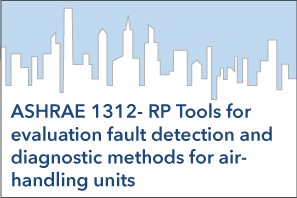Project Title:
ASHRAE 1312-RP Tools for Evaluating Fault Detection and Diagnostic Methods for Air-Handling Units
Principal Investigator:
Jin Wen
Co-Investigator:
Shun Li
Collaborators:
Iowa Energy Center Energy Resource Station
Funding Agency:
ASHRAE
Funding Period:
2006-2011
Abstract:
An air handling unit (AHU) connects primary heating and cooling plants with building zones, controls building ventilation air intake, and greatly affects the energy consumed for heating, cooling, and ventilating, as well as supply air temperature and humidity levels. An AHU’s operation significantly impacts building energy use, health, and comfort aspects. A dynamic AHU simulation model that is capable of producing operational data for commonly used AHU configurations will assist further research in AHU control and operation, as well as fault detection and diagnosis.
In this study, dynamic behaviors of an AHU and four building zones that are served by the AHU are modeled using HVACSIM+ software developed by the National Institute of Standards and Technology. The model (called 1312 model hereafter) is developed based on two previous ASHRAE projects (RP 825 and RP 1194). However, significant modifications, including new parameters, control strategies, and component models, which are a new coil valve model and a new fan energy model, are developed in this study to ensure that the 1312 model simulates the dynamic behavior of the systems in the test facility. The new coil valve model considers nonlinear behaviors of a three way valve. The new fan energy model outputs fan energy consumption that includes energy consumptions for fan, belt, motor and VFD. Coefficients for the new fan energy model can directly be estimated from the total fan energy measurement.
The developed 1312 AHU model is then systematically validated using experimental data for both fault free and faulty operation. Strategies to validate the model using experimental data mostly from common system operations are designed. If problems were identified using system operation data, follow up component model calibration is used to modify and improve the model. A series of experiments are designed and implemented to obtain pressure resistance parameters for the supply duct system and mixing box dampers. Building operation data from winter, summer, and spring seasons are used to validate the 1312 model. Good agreements are achieved between experimental data and simulation outputs for the 1312 AHU model, especially for summer and winter seasons. When using 1312 model to simulate AHU operation for spring season conditions, simulated outdoor and supply air flow rates and supply air temperature, while tracking experimental data, showed certain level of oscillation.
Common AHU faults, including their features and severities, are identified in this project. Existing experimental data that can be used to validate the 1312 AHU model under fault free and faulty operation conditions are collected. Additional experiments are performed to thoroughly validate the 1312 AHU model under both fault free and faulty operation conditions. The fault models are able to replicate all major fault symptoms although detailed dynamics between simulated data and measured data do not always overlap.
